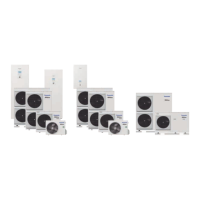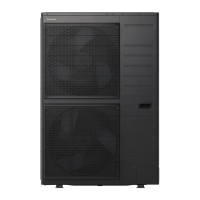
Do you have a question about the Panasonic Aquarea WH-SQC16H9E8 and is the answer not in the manual?
Explains safety notes, warning symbols, and text representations used in the manual for safe product use.
Details safety precautions to prevent device damage from incorrect refrigerants, vibrations, or improper installation.
Explains the fundamental operating principle of an air-to-water heat pump using ambient heat.
Discusses ambient air as a heat source, considering temperature variations and noise generation.
Details the heat pump system, covering its functioning, characteristics, and operating modes.
Distinguishes between bi-bloc and mono-bloc system types and their configurations.
Summarizes key product features related to energy efficiency, comfort, operation, and maintenance.
Technical data for All in One systems, H Generation, with R410A refrigerant.
Technical data for All in One Compact systems, J Generation, R32 refrigerant.
Technical data for All in One Compact systems, H Generation, R410A refrigerant.
Technical data for Aquarea T-CAP H Generation systems, single/three phase, R410A refrigerant.
Technical data for Aquarea T-CAP H Generation Super Quiet systems, three phase, R410A refrigerant.
Technical data for Aquarea T-CAP H Generation Compact systems, single phase, R410A refrigerant.
Technical data for Bi-bloc systems, Aquarea High Performance J Generation, R32 refrigerant.
Technical data for Bi-bloc systems, Aquarea High Performance H Generation, R410A refrigerant.
Technical data for Bi-bloc systems, Aquarea T-CAP H Generation, R410A refrigerant.
Technical data for Bi-bloc systems, Aquarea T-CAP H Generation Super Quiet, R410A refrigerant.
Technical data for Bi-bloc systems, Aquarea HT F Generation, R407C refrigerant.
Technical data for mono-bloc systems, Aquarea High Performance H Generation, R410A refrigerant.
Technical data for mono-bloc systems, Aquarea T-CAP H Generation, R32 refrigerant.
Technical data for mono-bloc systems, Aquarea T-CAP H Generation, R410A refrigerant (3-phase).
Technical data for mono-bloc systems, Aquarea HT G Generation, R407C refrigerant.
Details the control system, including remote controller functions and external interfaces.
Explains the operation and programming of the remote controller for Aquarea heat pumps.
Presents technical data for combo tanks, including dimensions and energy efficiency.
Covers technical criteria for refrigeration, including outside temperature and heat load determination.
Explains how to determine the design outside temperature and calculate the building's design heat load.
Guides on estimating domestic hot water demand based on comfort expectations and recommended tank sizes.
Defines heat pump operating modes and explains how to determine the bivalence point for cost efficiency.
Provides a step-by-step example for calculating the total heating capacity needed for a system.
Covers criteria for installation, including acoustics, bi-bloc, and mono-bloc system installation.
Addresses acoustic considerations, explaining sound pressure levels and calculation methods.
Provides essential guidelines for installing bi-bloc systems, including pipe lengths and distances.
Specifies conditions for outdoor unit installation, including placement, heat emission, and noise considerations.
Illustrates minimum required distances for outdoor units relative to walls and objects for optimal airflow.
Details methods for securing the outdoor unit on foundations or floor plates and wind bracing.
Outlines requirements for the installation room for indoor units, including volume and ventilation.
Defines limitations on refrigerant quantity relative to floor area for R32 models based on safety standards.
Specifies conditions for indoor unit installation, including environment, airflow, and noise.
Illustrates minimum required distances for indoor units (hydrokit/All in One) from walls and floor.
Provides guidelines for installing mono-bloc systems, emphasizing outdoor installation and pipe insulation.
Specifies conditions for mono-bloc unit installation, including placement and noise considerations.
Illustrates minimum required distances for mono-bloc units relative to walls and objects for optimal airflow.
Details methods for securing the mono-bloc unit on foundations or floor plates and wind bracing.
Covers aspects of hydraulic integration, pump discharge head, and pipe network resistance.
Explains the integrated water circulation pump and the importance of hydraulic separation.
Describes hydraulic balancing as optimizing flow rates for comfort and efficient heat pump operation.
Emphasizes the importance of heating water quality to prevent pipe corrosion and system damage.
Covers electrical connections, power sources, and wiring requirements for safe installation.
Provides essential safety warnings and requirements for electrical connections to the power source.
Provides heating and cooling capacity data based on supply water and outside temperatures.
Illustrates various application examples for Aquarea air-to-water heat pumps with hydraulic schematics.
Highlights critical safety notes to be observed before and during the installation process.
Provides crucial safety warnings regarding electrical shock hazards during installation.
Warns about the risk of injury due to the heavy weight of devices and advises on proper handling.
Details the procedure for creating wall holes, including dimensions and safety precautions.
Provides instructions for setting up various device types, including indoor units and outdoor/mono-bloc units.
Outlines steps for installing All in One units and Hydrokits, including mounting procedures.
Provides instructions for installing outdoor units and mono-bloc units on foundations or wall brackets.
Details the process of connecting the refrigeration circuit, including requirements for flare fittings.
Provides step-by-step instructions for connecting refrigerant pipes to the indoor unit.
Details steps for connecting refrigerant pipes to the outdoor unit, including opening and securing.
Provides instructions for connecting the heating circuit, including safety warnings and procedures.
Warns about the risk of Legionella growth in open water circuits and advises using closed systems.
Warns about potential damage to mono-bloc units from freezing pipes and suggests preventative measures.
Warns about pipe corrosion in open systems due to oxygen ingress and recommends closed systems.
Advises on proper working methods to prevent damage to water-side components during heating circuit connection.
Details steps for connecting water pipes of the heating circuit to indoor units or mono-bloc units.
Provides instructions for connecting condensation and water drain pipes, with safety notes.
Details steps for connecting the condensation drain hose to indoor units.
Details steps for connecting the drain pipe to the safety valve drainage tap of the All in One unit.
Provides instructions and safety warnings for connecting the electrical wiring.
Critical warning about life-threatening electrical shock hazards due to improper installation.
Warns about potential damage from unprofessional electrical wiring practices.
Details requirements for correct cable connections, including insulation stripping and terminal insertion.
Provides instructions for connecting the power cord to the indoor unit and other devices.
Details steps for connecting the power cord to indoor units, All in One units, and hydrokits.
Provides steps for connecting the cable between indoor and outdoor units for bi-bloc systems.
Details steps for connecting the power cord to mono-bloc units.
Provides instructions for connecting optional accessories to indoor and mono-bloc units.
Details steps for connecting accessory cables to the indoor unit's external interfaces.
Details steps for connecting accessory cables to the mono-bloc unit's external interfaces.
Describes the installation and connection of the remote controller for J and H generation models.
Warns about risks of electrical shock or fire from unprofessional remote controller installation.
Warns about potential damage or malfunctions caused by unprofessional remote controller installation.
Covers the commissioning process: refrigerant circuit evacuation, water system filling, test run, and handover.
Details the procedure for evacuating the refrigerant circuit and performing a pressure test.
Warns about device damage from incorrect refrigerants and safety risks.
Warns against using incorrect refrigerants, which can cause damage and safety risks.
Emphasizes the mandatory evacuation of the system to prevent faults from humidity or foreign gases.
Stresses the importance of preventing refrigerant emission to the environment during maintenance.
Provides instructions for filling and venting the hot water tank and heating/cooling circuits.
Details the steps for filling the hot water tank of All in One units and third-party tanks.
Provides steps for filling and venting the heating or cooling circuit, including air purge valve operation.
Outlines the steps for checking the system after installation, including pressure and leakage checks.
Details the procedure for performing a test run to ensure proper system operation.
Describes the process of system handover, including commissioning report completion and customer instruction.
Provides steps to check system pressure on the manometer and top up fluid if needed.
Details the procedure to check the pressure relief valve by setting its lever to open and closed positions.
Provides steps for cleaning strainers, including closing valves, removing elements, and rinsing.
Outlines steps to check the functionality of the residual current circuit breaker (RCCB) using the TEST button.
Details the procedure for checking the air purge valve and venting the system to remove air.
Explains how to reset the thermostatic overload protection if triggered by high water temperature.
Provides steps for performing maintenance on the refrigerant circuit, including pump-down operation.
Warns about dangers associated with unprofessional handling of refrigerants.
Highlights dangers from refrigerant handling including freezing, fire, explosion, and intoxication.
Provides access to four major functions or modes: Heat, Cool, Auto, and Tank.
Provides access to installer setup and service setup menus.
Lists common symptoms and their potential causes, and checks to perform before calling for service.
Lists error codes that may appear on the display and their corresponding explanations.











